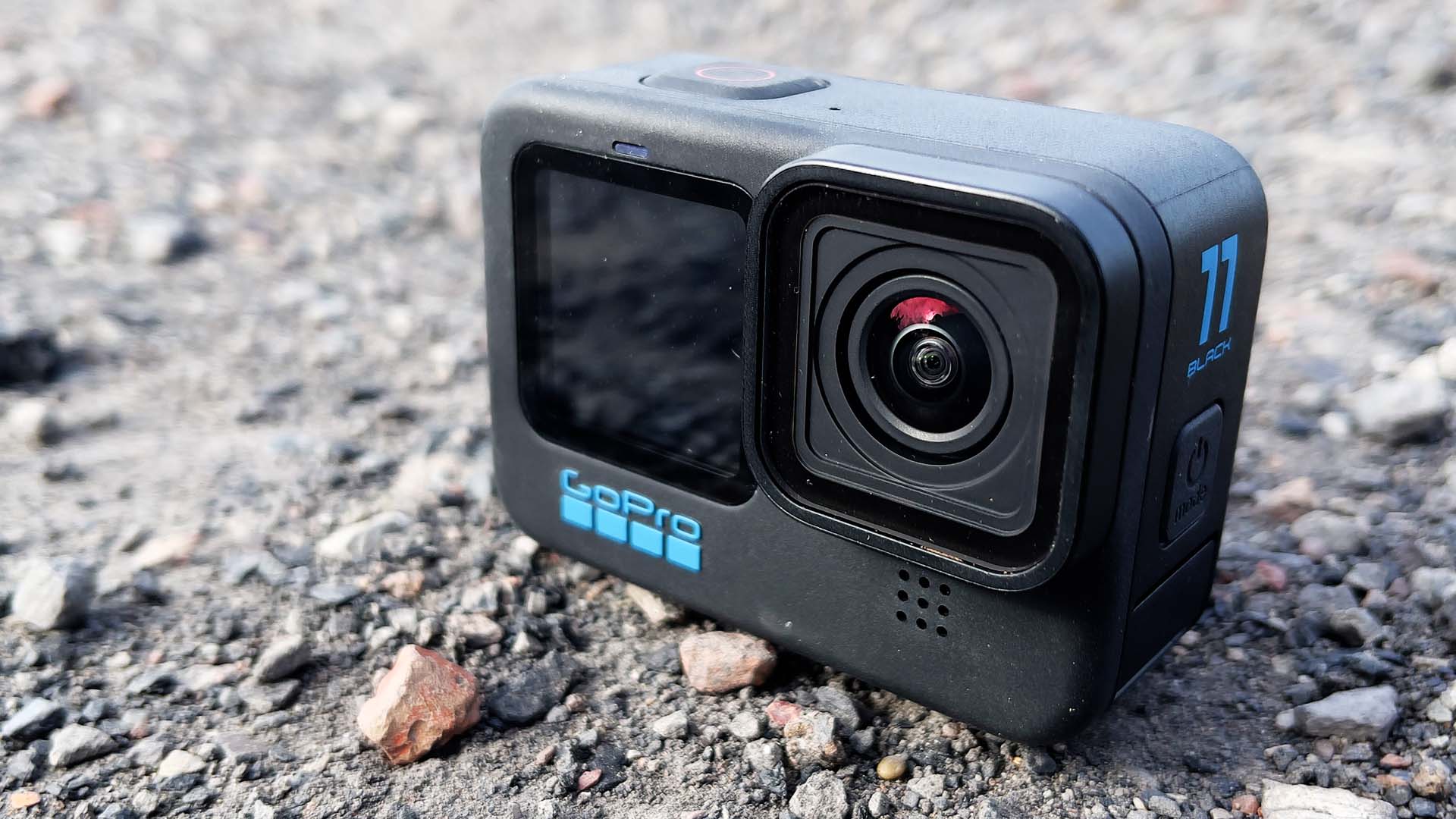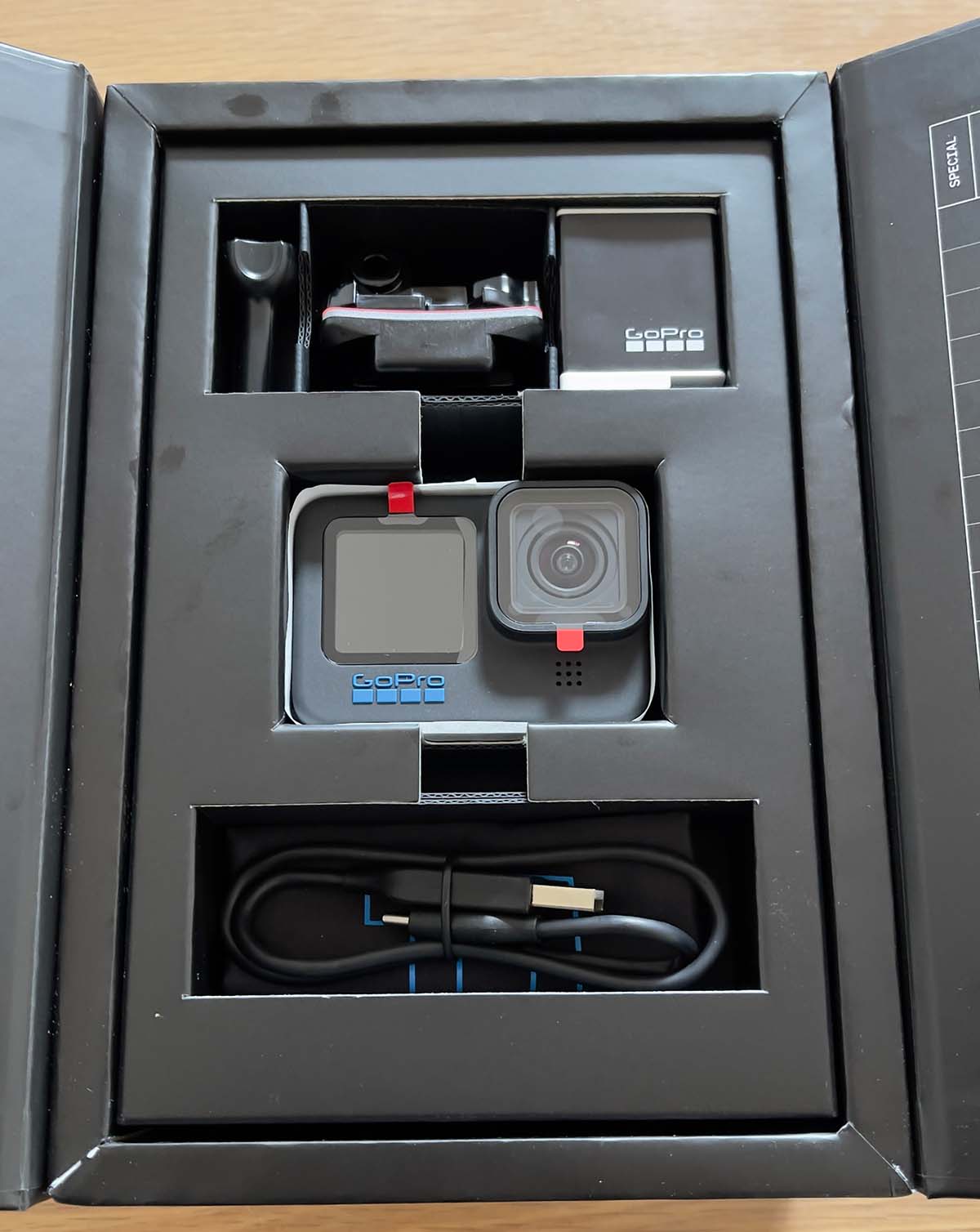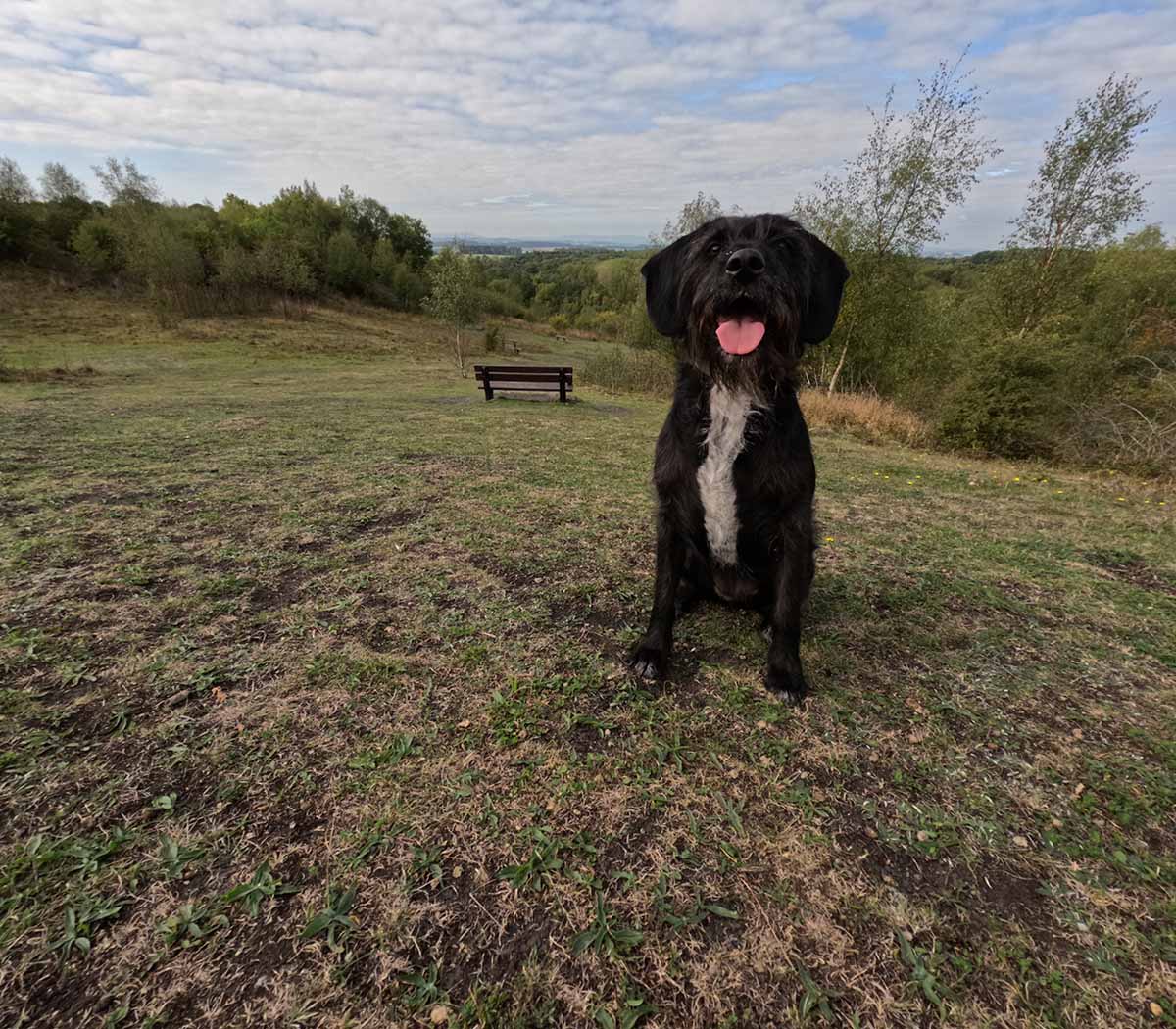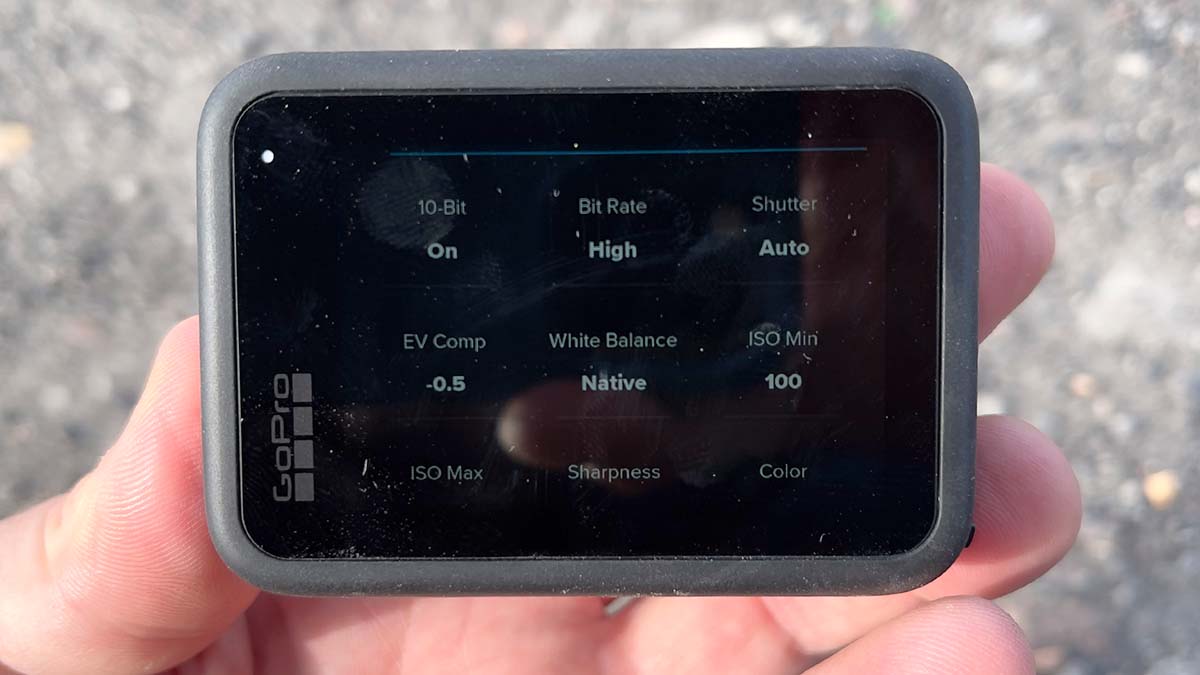
GoPro's new HERO11 is here, and we've been taking it through its paces. Does it offer enough to stay at the top?
Every year the new GoPro HERO announcement is hotly anticipated. This year, just like last, was accompanied by several very accurate leaks, meaning that most people already knew the additional features on offer before the official announcement. But beyond paper specifications, what do the new features mean in practice?
Open the box
Outwardly, the HERO11 looks the same as the HERO10, save for the number 11 on the side. However, the camera now comes with the higher performance Enduro battery as standard, so many of the endurance issues that plagued the HERO10 on its release shouldn't be so problematic out of the gate here.

The contents of the review box. Note that the retail box is different.
The HERO11 has a new, larger 27MP 1/1.9" 8x7 ratio sensor. The added resolution comes in a taller capture area, which opens up quite a few options that are impossible on the HERO10.
The taller sensor means that you can effectively shoot your imagery without being forced to choose your aspect ratio or digital lens at the time of shooting. For example, if you often need to output for 9:16 ratio social media stories, but you also need 16:9 for YouTube, you can now do so without sacrificing resolution. Your 9:16 video will gain extra field of view in the vertical plane, while you can simply take the 16:9 crop for YouTube, with the additional advantage of having some reframing ability.
GoPro has said that it will make the mobile and desktop apps capable of applying all the digital lens options after shooting 8:7 video.
In practice, 8:7 works out well because it takes the pressure off having to lock in a particular FOV setting. This is particularly handy if you want to move fast and don't have time to go through menu settings.
The added height of the sensor makes a new mode, HyperView, possible as well. One thing that I am always after is a much wider, more immersive POV setting. For kayaking, I usually use SuperView, which performs a dynamic stretch to the image by keeping the centre undistorted but stretching out towards the left and right edges. HyperView is very similar to SuperView, but utilises the extra height of the sensor, giving an even more immersive view.
HyperView creates a highly distorted image, but it works exceptionally well for its intended purpose, which is immersive POV shots during fast action, and I love it. Previously, DJI's Action 2 held the crown for the widest FOV on an action camera, but now HyperView has closed the gap.

Dolly approves of SuperPhoto.
10-bit colour
Okay, let's talk about what must be the most requested feature on a GoPro, 10-bit colour. I must admit that I never thought it would ever happen, at least not for a long while, so its inclusion took me by surprise. So what does it mean in practice?
10-bit colour refers to the number of available shades of colour available. In 8-bit colour, which was featured on previous GoPro's, 256 shades of each colour are available, giving 16 million shades of colours in total. 10-bit might only sound a small difference, but in practice it means that you get 1024 shades of each colour, giving 1.07 billion shades of colour in total.
10-bit colour is one of those options you will get most use of if you are a power user who requires the ultimate flexibility for grading or matching to other cameras. You are unlikely to notice a difference if you only record for output without grading or just simple colour correction, unless you look very closely. However, for people doing lots of secondary correction and pushing the grade, selecting 10-bit gains you a noticeable amount of tonal depth. I've provided some screen grabs below to demonstrate the difference when the grade is pushed to the extreme.

8-bit colour being pushed to extremes in the grade. This 300% crop from a GoPro HERO10 shows the banding/posterisation between the shades of colour where the tonal depth has been limited.

This is a 300% crop of the same angle, but taken in 10-bit colour with the HERO11. You can clearly see that the banding and posterisation has been greatly reduced, giving more flexibility for adjustment.
Having 10-bit now means that the camera's log (Flat) mode is much more useful. I've noticed that the HERO11 seems to hold more shadow detail than the HERO10, as well as handling high contrast conditions slightly better, even in the Natural and Vivid picture profile settings. For example, strong sunlight shining through tree branches looks less harsh with more subtle detail. There's also better handling of detail on highly saturated objects and clothing in bright sunshine.
GoPro has increased the bitrate by 20Mb/s to account for the 10-bit colour. You might think this isn't enough, but the HERO11 no longer has an H.264 option. Instead, everything is now recorded using the HEVC (H.265) codec, but the story doesn't end there. If you need higher bitrates, just like with the HERO10, you can install the Labs firmware and use it to set the bitrate to 200Mb/s. That's a higher bitrate than some mirrorless cameras record internally.
10-bit colour isn't available in all modes. It's available in most of them but it can't be used for high frame rate 120fps filming. For a large percentage of users, 10-bit won't be a function that they need to enable, but certainly, for those who are using the camera for a more professional application, it's a welcome addition and gives the HERO11 a clear advantage for power use over rival cameras.
To my eye, the picture looks ever so slightly cooler than the HERO10. In the Natural picture profile, for instance, the HERO10 gives somewhat warmer skin tones, but there's not much in it.

A shot taken with the HERO10, EV set to -1, Natural colour profile, sharpness low.

The shot from the HERO11 taken on a dual mount next to the HERO10 using the same settings. The image is slightly darker, but the highlights on the clothing contain more detail. Shadows can be brought up easily.
HyperSmooth performance
HyperSmooth has been an incredible performer since it was introduced on the HERO7 and has seen incremental improvements ever since. The taller sensor on the HERO11 means that there's much more image area on the vertical plane for HyperSmooth to work its magic. Furthermore, the new sensor has opened up complete 360-degree horizon levelling without needing the Max Lens Mod. The mode is enabled when you use Linear+Horizon Levelling. Linear mode removes the fisheye distortion and crops in a bit, but the view is still usefully wide unless you need it for POV. If you want the most expansive view with horizon levelling, you'll still need the Max Lens Mod.
That said, some really neat shots can be made with this, and whilst you can only shoot up to 30p in 5.3K and 60p in 4K, if you drop the resolution down to 2.7K, you can get up to 120fps for some creative angles. I think I will have a lot of fun with this mode, mainly because the Max Lens Mod is prone to water droplets, while the default standard lens cover on the HERO11 is hydrophobic.
There's a new AutoBoost mode too. I haven't done enough to evaluate this mode fully, but it does appear to work pretty well. AutoBoost smoothly crops into the image to give the widest angle of view combined with the maximum amount of stabilisation. This is similar to how the GoPro ReelSteady software stabilisation works. If you want to retain a consistent angle of view, this might not be the mode to use, but when you want the absolute steadiest shot and keep as wide a view as possible at any given moment, AutoBoost appears to work very nicely.

The menus on the HERO11 are fast and responsive.
Battery life and performance
In general use, the HERO11 is very similar to the HERO10. The interface is still very smooth and responsive, and GoPro has now enabled two modes of operation, Easy and Pro. Easy is for casual users who want to get on and film their adventures with the minimum amount of setup. Pro mode enables all of the settings and adjustments that power users require.
Battery life is very similar to the HERO10 (assuming you are using both with the Enduro battery), with the HERO11 having a slight edge through optimisation. The camera will still shut down due to thermal overloading, but this is expected when you put so much power into a tiny camera body like this. Having said that, I managed to get the camera to record for 19 minutes and 32 seconds indoors in 4K at 120fps before it shut down, and I still had over 60% battery remaining. Of course, nobody really needs to record anything like that length of time at 120fps, so it's not very representative of real world recording. But I know YouTube will be full of similar tests, and it's essential to shed some realistic perspective on the matter.
Thermal shutdowns take place for a couple of reasons. The first is to protect the camera's components from damage. The second is regulatory, since different countries place rules on how hot a device can become to the touch. In other words it's a safety feature. When the HERO11 is used in its intended environment, ie outside with some sort of airflow or water splashing onto it, thermal issues don't really exist.
In all other modes, I've had absolutely no issues at all with reliability. Again, it's important to point out that many problems with lockups and errors people have had in the past are primarily due to the type of SD card being used. With the HERO11, I would certainly recommend you get one of the fastest cards you can. I've been using a Pro Grade Digital Micro SD card rated at V60, and I've had no problems at all. In fact the camera has been flawless in operation for me so far.
Conclusions
Initially, the changes to the HERO11 over the HERO10 might seem relatively incremental. Indeed, the HERO10 is still a powerhouse action camera that will serve many users purposes very well indeed. The question of whether to upgrade to the HERO11 from the 10 is very quickly answered. Suppose you demand the absolute best image quality and regularly run up against limitations in terms of colour space for grading or need to match it to bigger cameras. In that case, the HERO11 will be worth the upgrade for the 10-bit colour alone. If this is your first action camera, the HERO11 is a fantastic starting point. Similarly, if you own one of the older models, such as the HERO7, or even 8, then the 11 offers substantially new functionality, albeit in a slightly larger form factor. For users who need a less bulky camera, it might be worth waiting for the HERO11 Black Mini to arrive in October, which features the same sensor and shooting modes as the standard model but is much more suited to head or helmet mounting.
Looked at in isolation, the HERO11 is still very much at the top of the action camera ladder. 10-bit colour puts it out in front of the competition, and the new 8:7 ratio sensor has opened up a whole new world of flexibility in distributing the footage and an impressive horizon levelling mode.
The GoPro HERO11 Black is available for $399.98 with a GoPro subscription or $499.99 without. Since the subscription comes as part of the lower price, it's worth going with that option.



Comments